Efergy e2 power meter
-
Hi,
I just published on github (https://github.com/gtortone/MySensors-Efergy-e2) my last work about integration of Efergy e2 power meter with MySensors. The Efergy e2 electricity monitor (http://efergy.com/it/products/electricity-monitors/e2-classic) provides a sensor that wirelessly sends information about the amount of electricity you are using to the display monitor. The monitor converts this into kilowatt-hours.This sketch use a JeeNode v5 (http://jeelabs.net/projects/hardware/wiki/JeeNode) equipped with 433/868 MHz RFM12B module (www.hoperf.com/upload/rf/RFM12B.pdf) configured in OOK mode to capture wireless data (on pin D3) and forward it through NRF24L01+ with MySensors library.
Comments and suggestions are very welcome !
Regards,
Gennarop.s. photos will be published soon !
-
Hi,
I just published on github (https://github.com/gtortone/MySensors-Efergy-e2) my last work about integration of Efergy e2 power meter with MySensors. The Efergy e2 electricity monitor (http://efergy.com/it/products/electricity-monitors/e2-classic) provides a sensor that wirelessly sends information about the amount of electricity you are using to the display monitor. The monitor converts this into kilowatt-hours.This sketch use a JeeNode v5 (http://jeelabs.net/projects/hardware/wiki/JeeNode) equipped with 433/868 MHz RFM12B module (www.hoperf.com/upload/rf/RFM12B.pdf) configured in OOK mode to capture wireless data (on pin D3) and forward it through NRF24L01+ with MySensors library.
Comments and suggestions are very welcome !
Regards,
Gennarop.s. photos will be published soon !
-
Hi,
I just published on github (https://github.com/gtortone/MySensors-Efergy-e2) my last work about integration of Efergy e2 power meter with MySensors. The Efergy e2 electricity monitor (http://efergy.com/it/products/electricity-monitors/e2-classic) provides a sensor that wirelessly sends information about the amount of electricity you are using to the display monitor. The monitor converts this into kilowatt-hours.This sketch use a JeeNode v5 (http://jeelabs.net/projects/hardware/wiki/JeeNode) equipped with 433/868 MHz RFM12B module (www.hoperf.com/upload/rf/RFM12B.pdf) configured in OOK mode to capture wireless data (on pin D3) and forward it through NRF24L01+ with MySensors library.
Comments and suggestions are very welcome !
Regards,
Gennarop.s. photos will be published soon !

Photo #1: Efergy E2 OOK signal decoded by Zeroplus logic analyzer
Photo #2: JeeNode module with RFM12B radio module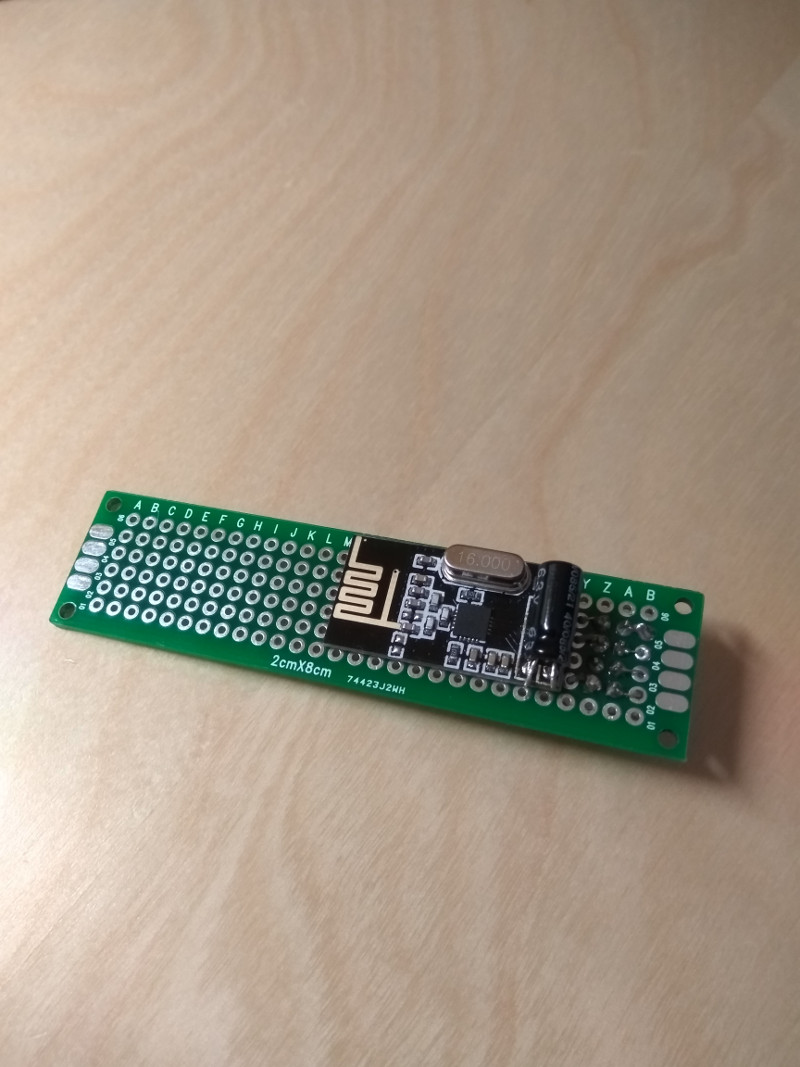
Photo #3: NRF24L01+ JeeNode shield pluggable on SPI header of JeeNode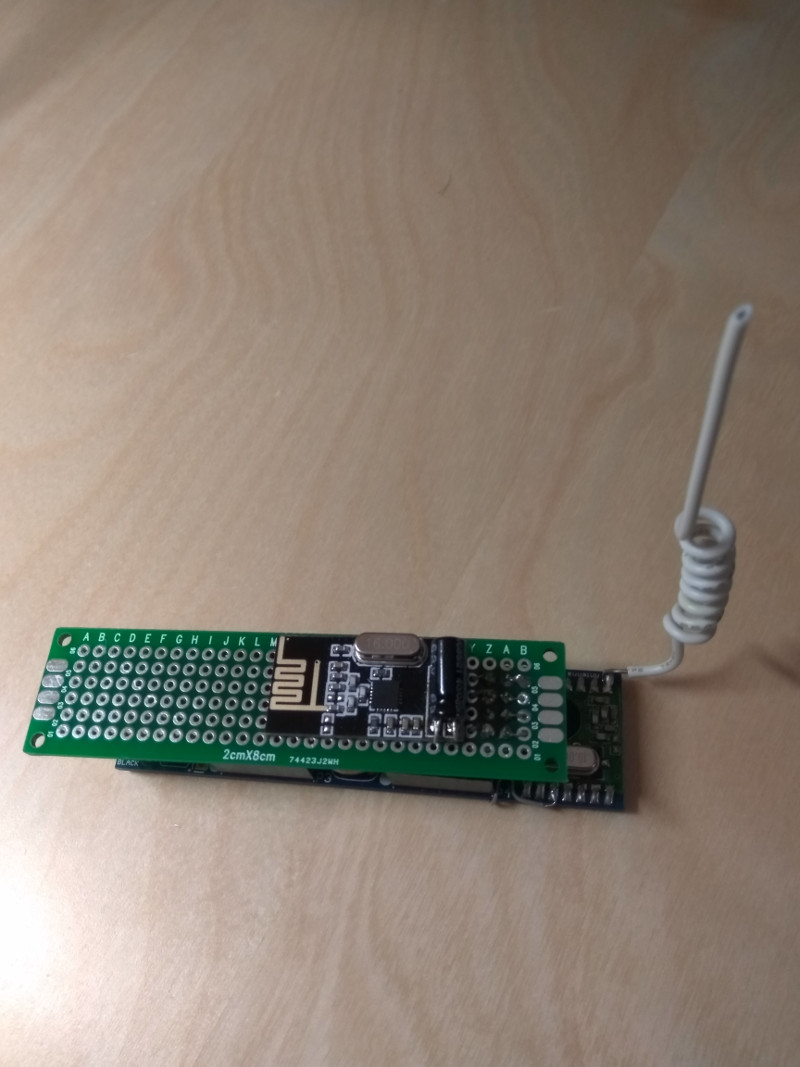
Photo #4: Final result !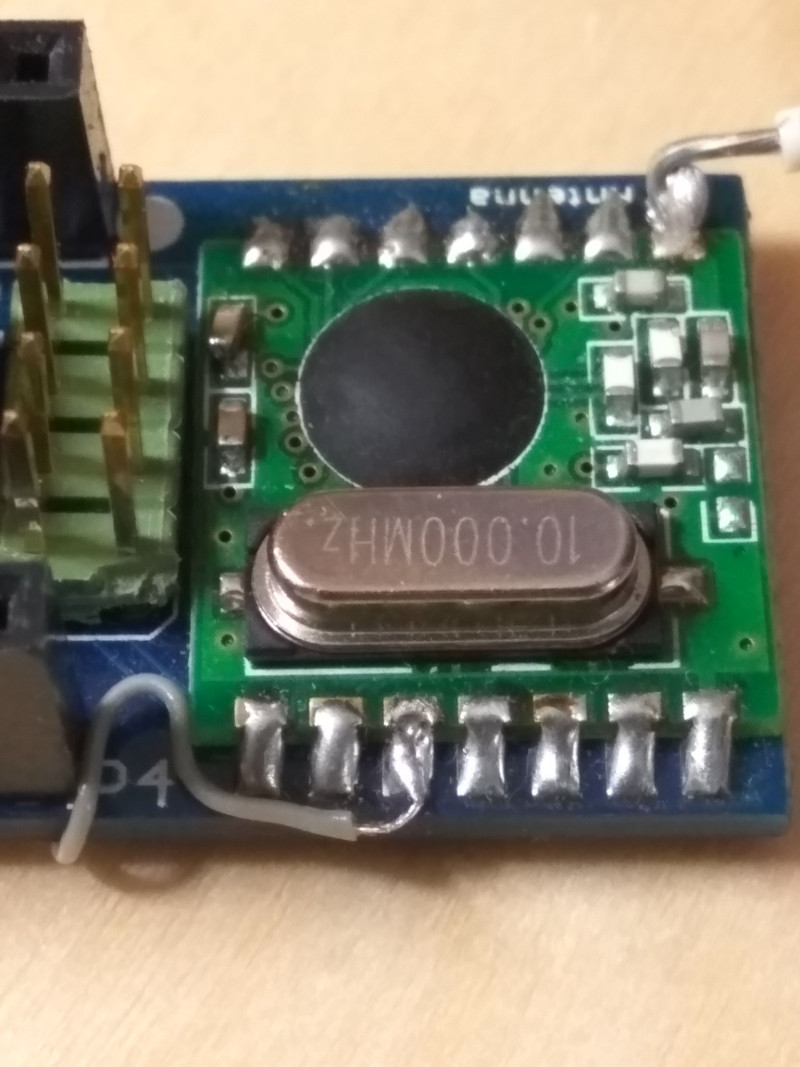
Photo #5: Detail of RFM12B Data pin routed to D3 in order to perform software OOK decoding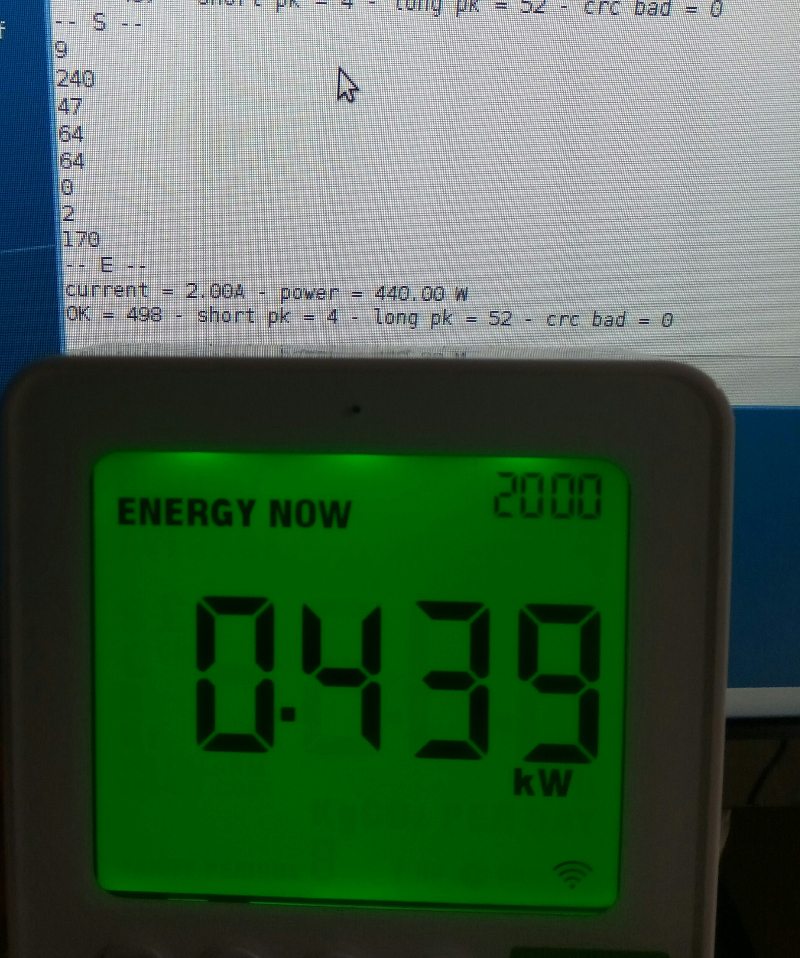
Photo #6: Efergy power meter display shows same value of software !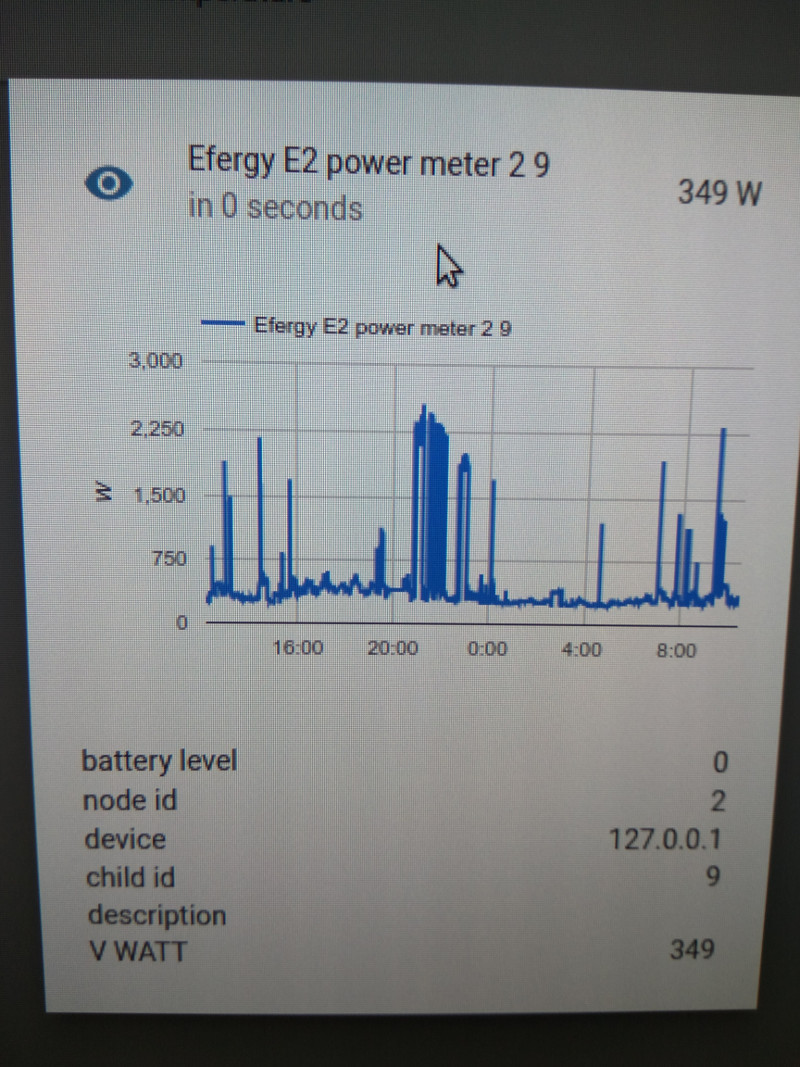
Photo #7: First data gathered by Home Assistant (https://home-assistant.io) on Raspberry PI 3Some notes:
-
I'm using a RFM12B radio module tuned for 868Mhz equipped with 433 MHz antenna... but everything goes fine due to RFM12B has frequency tuning
-
I plan to do another setup using a simple 433 Mhz receiver or other Hoperf 433 Mhz receiver module (RFM12B are obsoleted modules)
-
-
@gtortone very nice! I think I have one of these efergy e2s collecting dust. I would love to get more info on how you connected the RFM12B and where you purchased it from so I can get the correct type.
@korttoma said:
@gtortone very nice! I think I have one of these efergy e2s collecting dust. I would love to get more info on how you connected the RFM12B and where you purchased it from so I can get the correct type.
Hi, as you can see in photos I just posted, you need to connect DATA pin of RFM12B to a digital input of Atmega328P (it must be a pin suitable for interrupt).
RFM12B modules are not longer available... I have some of these (old) modules (all of them tuned for 868 Mhz) but I will do some tests with a cheap 433 MHz receiver (like this one: http://bit.ly/2gl6yXJ) or with a recent Hoperf transceiver modules (RFM69)
Thanks,
Gennaro -
@korttoma said:
@gtortone very nice! I think I have one of these efergy e2s collecting dust. I would love to get more info on how you connected the RFM12B and where you purchased it from so I can get the correct type.
Hi, as you can see in photos I just posted, you need to connect DATA pin of RFM12B to a digital input of Atmega328P (it must be a pin suitable for interrupt).
RFM12B modules are not longer available... I have some of these (old) modules (all of them tuned for 868 Mhz) but I will do some tests with a cheap 433 MHz receiver (like this one: http://bit.ly/2gl6yXJ) or with a recent Hoperf transceiver modules (RFM69)
Thanks,
Gennaro@gtortone maybe we could even use one of these RXB6 433Mhz Superheterodyne Wireless Receiver Modules I used one for another project.
-
Hi again @gtortone
I finally found my efergy device from the bottom of a drawer.
It says Model No: TX (ENGAGE HUB) on the back of the transmitter.
And HK-1.0-UK on the ethernet hub device .I tried some libraries with my cheep 433MHz receiver module but I do not get anything.
I guess I will have to wait for the RFM12b to get here and try your code and hope it works.Unless you have some idea how to use one of these cheep receivers? Or know about some good Library to sniff the code?
-
Hi again @gtortone
I finally found my efergy device from the bottom of a drawer.
It says Model No: TX (ENGAGE HUB) on the back of the transmitter.
And HK-1.0-UK on the ethernet hub device .I tried some libraries with my cheep 433MHz receiver module but I do not get anything.
I guess I will have to wait for the RFM12b to get here and try your code and hope it works.Unless you have some idea how to use one of these cheep receivers? Or know about some good Library to sniff the code?
Hi @korttoma,
I did not tested cheap 433 MHz modules yet... I will receive a couple of them next week !
anywai RFM12b is a great module that has interesting features like frequency tuning and adjustable gain...If I will have updates on cheap modules I will update this thread !
-
I have now received the RFM12b module, unfortunately I will not have time to set it up for the next 2 weeks but until then.
Could you clarify how I need to wire it?
Is it really enough to have RFM12B Data pin routed to D3?
Do I need to somehow reprogram it using ISP to work in OOK mode?Did you have a chance to try any cheep 433MHz receiver yet?
-
I have now received the RFM12b module, unfortunately I will not have time to set it up for the next 2 weeks but until then.
Could you clarify how I need to wire it?
Is it really enough to have RFM12B Data pin routed to D3?
Do I need to somehow reprogram it using ISP to work in OOK mode?Did you have a chance to try any cheep 433MHz receiver yet?
Hi,
you need to connect RFM12b module to Arduino following this schematic (you can avoid to connect IRQ line...)http://jeelabs.net/attachments/download/331/jlpcb-128.pdf
after this cabling you need to connect RFM12b DATA pin to Arduino D3 pin (you can select a different pin but modify
code accordingly...)only after this you can use the Mysensors-Efergy-e2 sketch (https://github.com/gtortone/MySensors-Efergy-e2) to get
RF data;I tested my code with cheap RF modules (I received them some days ago) but the performance of these modules are very
poor... I will try to do other work on cheap RF modules in the future...Thanks !
-
Hi,
you need to connect RFM12b module to Arduino following this schematic (you can avoid to connect IRQ line...)http://jeelabs.net/attachments/download/331/jlpcb-128.pdf
after this cabling you need to connect RFM12b DATA pin to Arduino D3 pin (you can select a different pin but modify
code accordingly...)only after this you can use the Mysensors-Efergy-e2 sketch (https://github.com/gtortone/MySensors-Efergy-e2) to get
RF data;I tested my code with cheap RF modules (I received them some days ago) but the performance of these modules are very
poor... I will try to do other work on cheap RF modules in the future...Thanks !
@gtortone thanks for the clarification on the wiring of the RFM12b.
In what way was the performance of cheap RF radio poor? Is the range just bad or does it miss transmissions? The first cheap radios I got also had poor reception, this is why I upgraded to the RXB6 from my earlier post. Can you share the code you used with the cheap RF radios maybe my RXB6 module performs better?
-
@gtortone thanks for the clarification on the wiring of the RFM12b.
In what way was the performance of cheap RF radio poor? Is the range just bad or does it miss transmissions? The first cheap radios I got also had poor reception, this is why I upgraded to the RXB6 from my earlier post. Can you share the code you used with the cheap RF radios maybe my RXB6 module performs better?
Hi, I have these modules:
http://www.banggood.com/433Mhz-RF-Transmitter-With-Receiver-Kit-For-Arduino-ARM-MCU-Wireless-p-74102.html?rmmds=searchthe range is only few centimeters... I will try to do some antenna tuning but I don't expect any significative improvement.
If you want to try with your RXB6 module the code is always the same, you have only to remove the configuration code lines related to RFM12b configuration;
-
Hi, I have these modules:
http://www.banggood.com/433Mhz-RF-Transmitter-With-Receiver-Kit-For-Arduino-ARM-MCU-Wireless-p-74102.html?rmmds=searchthe range is only few centimeters... I will try to do some antenna tuning but I don't expect any significative improvement.
If you want to try with your RXB6 module the code is always the same, you have only to remove the configuration code lines related to RFM12b configuration;
@gtortone that is the same useless junk I got from e-bay at first, range is terrible.
This gives me some hope to get this working with the RXB6. I will test this as son as I can (might be a few weeks until I can).
-
Hi @gtortone ,
I finally found some time to hock up the RFM12B. Seems to be almost working. I just get the value "inf" for current. Do I have some datatype problem or maybe it should be calculated differently my Efergy engage hub?
I'm using a Arduino Pro Mini 3.3VAttached the serial print.0_1484211281663_efergyLog.txt
I should see values around 100W most of the time and some smaller down to 30W.
Edit: It seems like it might be payload[6] that is equal to 255 at 100W and 254 at under 40W that is causing problems with the calculation.
Edit2: Took 3 samples at around 30W, 60W and 100W. 0_1484220204136_efergyLog2.txt I need to find something so that I could test higher values to so I could figure out the formula to use.
-
Hi @gtortone ,
I finally found some time to hock up the RFM12B. Seems to be almost working. I just get the value "inf" for current. Do I have some datatype problem or maybe it should be calculated differently my Efergy engage hub?
I'm using a Arduino Pro Mini 3.3VAttached the serial print.0_1484211281663_efergyLog.txt
I should see values around 100W most of the time and some smaller down to 30W.
Edit: It seems like it might be payload[6] that is equal to 255 at 100W and 254 at under 40W that is causing problems with the calculation.
Edit2: Took 3 samples at around 30W, 60W and 100W. 0_1484220204136_efergyLog2.txt I need to find something so that I could test higher values to so I could figure out the formula to use.
Hi @korttoma,
happy to read that you are getting "reasonable" values from RFM12B !!but I agree that in your case the decoding protocol needs some refinements...
just a question: your line voltage is 110 or 240 ?take into account that from Efergy current sensor you get the value of "current" and
not "power" than for 30W expected value from data is (V/30) [Ampere]... -
Hi @gtortone ,
I finally found some time to hock up the RFM12B. Seems to be almost working. I just get the value "inf" for current. Do I have some datatype problem or maybe it should be calculated differently my Efergy engage hub?
I'm using a Arduino Pro Mini 3.3VAttached the serial print.0_1484211281663_efergyLog.txt
I should see values around 100W most of the time and some smaller down to 30W.
Edit: It seems like it might be payload[6] that is equal to 255 at 100W and 254 at under 40W that is causing problems with the calculation.
Edit2: Took 3 samples at around 30W, 60W and 100W. 0_1484220204136_efergyLog2.txt I need to find something so that I could test higher values to so I could figure out the formula to use.
Hi @korttoma,
take a look to this decoding based on your collected data for 30W, 60W and 100W;everything seems to be ok !!
Regards,
Gennarop.s. I checked in your profile that you live in Finland and power voltage is 220/240 V :-)
- bytes #1: 0x09 fixed value
- bytes #2: 0X50 fixed value
- bytes #3: 0x2E fixed value
- bytes #4: 0x40 fixed value
- bytes #5: current MSB
- bytes #6: current LSB
- bytes #7: exponent
- bytes #8: CRC
- current detected = ((MSB << 8) + LSB / 65535) / pow(2, (255-exponent))
30 W = 0.13 A (@220V)
9 - 0x09
80 - 0x50
46 - 0x2E
64 - 0x4071 - 0x47
172 - 0xAC
254 - 0xFE
184 - 0xB80x47AC = 18348
current = 18348 / 65535 / pow(2, 1) = 0.139 A
60 W = 0.26 A (@220V)
9 - 0x09
80 - 0x50
46 - 0x2E
64 - 0x4069 - 0x45
29 - 0x1D
255 - 0xFF
40 - 0x280x451D = 17693
current = 17693 / 65535 / pow(2, 0) = 0.269 A
100 W = 0.45 A (@220V)
9 - 0x09
80 - 0x50
46 - 0x2E
64 - 0x40112 - 0x70
163 - 0xA3
255 - 0xFF
217 - 0xD90x70A3 = 28835 (10)
current = 28835 / 65535 / pow(2, 0) = 0.439 A
-
Thanks @gtortone your formula seems to work. I just need to find a way to test higher values.
I almost had the same formula but I did not have the "65535". Could you explain where you got this value from?
-- S -- 9 80 46 64 76 204 254 221 -- E -- abc_value = 19660current = 0.15A - power = 34.50 W 23701 TSF:MSG:SEND,9-9-0-0,s=9,c=1,t=17,pt=2,l=2,sg=0,ft=0,st=OK:34 OK = 4 - short pk = 0 - long pk = 0 - crc bad = 0 -- S -- 9 80 46 64 71 173 255 186 -- E -- abc_value = 18349current = 0.28A - power = 64.40 W 29693 TSF:MSG:SEND,9-9-0-0,s=9,c=1,t=17,pt=2,l=2,sg=0,ft=0,st=OK:64 OK = 5 - short pk = 0 - long pk = 0 - crc bad = 0 -- S -- 9 80 46 64 115 51 255 108 -- E -- abc_value = 29491current = 0.45A - power = 103.50 W 35688 TSF:MSG:SEND,9-9-0-0,s=9,c=1,t=17,pt=2,l=2,sg=0,ft=0,st=OK:103 OK = 6 - short pk = 0 - long pk = 0 - crc bad = 0 -
Thanks @gtortone your formula seems to work. I just need to find a way to test higher values.
I almost had the same formula but I did not have the "65535". Could you explain where you got this value from?
-- S -- 9 80 46 64 76 204 254 221 -- E -- abc_value = 19660current = 0.15A - power = 34.50 W 23701 TSF:MSG:SEND,9-9-0-0,s=9,c=1,t=17,pt=2,l=2,sg=0,ft=0,st=OK:34 OK = 4 - short pk = 0 - long pk = 0 - crc bad = 0 -- S -- 9 80 46 64 71 173 255 186 -- E -- abc_value = 18349current = 0.28A - power = 64.40 W 29693 TSF:MSG:SEND,9-9-0-0,s=9,c=1,t=17,pt=2,l=2,sg=0,ft=0,st=OK:64 OK = 5 - short pk = 0 - long pk = 0 - crc bad = 0 -- S -- 9 80 46 64 115 51 255 108 -- E -- abc_value = 29491current = 0.45A - power = 103.50 W 35688 TSF:MSG:SEND,9-9-0-0,s=9,c=1,t=17,pt=2,l=2,sg=0,ft=0,st=OK:103 OK = 6 - short pk = 0 - long pk = 0 - crc bad = 0Hi @korttoma,
the value 65535 or 32768 often is used as multiplier from sensor that send metric;
usually when you have to send a "small" float value (temperature, current) you can send it as integer
multiplied by a big constant instead of sending it with a float value converted in binary...I just refined my formula with this that is more close to formula I found for my Efergy using a small
constant:current = 18348 / 32768 / pow(2, 255-254 + 1) = 0.139 A
current = 17693 / 32768 / pow(2, 255-255 + 1) = 0.269 A
current = 28835 / 32768 / pow(2, 255-255 + 1) = 0.439 A -
Hi @gtortone I'm working on finalizing this node and I'm having some trouble with stability. The node stays alive from a few minutes to 30min and then stops communicating.
What kind of decoupling capacitors are you using in your setup?
I now have 2 pc 0.1uF, 2 pc 47uF and one 0.33uF.I use a HLK-PM03, a Pro Mini 3.3, and the NRF24L01+
Debugging output don't give me much to go in since it just stops responding.
-
Hi @gtortone I'm working on finalizing this node and I'm having some trouble with stability. The node stays alive from a few minutes to 30min and then stops communicating.
What kind of decoupling capacitors are you using in your setup?
I now have 2 pc 0.1uF, 2 pc 47uF and one 0.33uF.I use a HLK-PM03, a Pro Mini 3.3, and the NRF24L01+
Debugging output don't give me much to go in since it just stops responding.
-
Hi,
at the moment I'm defining some things in order to use RFM69 modules...
in the past, on my NRF24L01+ I was using 10 uF capacitor but I had same problems of "stop responding"...@gtortone My node has now been running for more then 40min since I added the 0.1uF and 0.33uF tantalum caps. I'm hoping this will be the solution for me since I have no tools to debug any disturbance like this.
EDIT: It failed again :(
